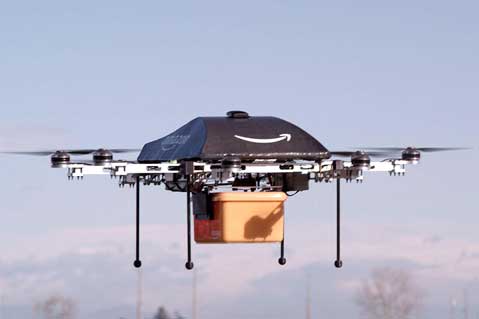News June 29, 2017
Amazon Seeks Patent for Drone Delivery Beehives
Amazon has taken another step toward a drone-filled future, filing for a patent for towers that would serve as multi-level fulfillment centers for its delivery drones. Filed in December 2015 and published by the U.S. Patent and Trademark Office last week, the patent application features several drawings of buildings resembling a beehive, UFO and cylinder. The facilities would be built vertically to blend in with city high-rises and include a self-service area where customers can pick up items. Traditional truck deliveries could be supported, too.

Since 2013, when Amazon unveiled its Prime Air program for drone delivery, the company has been working toward the technological advancements needed to match federal regulations. In April 2016, the company filed for a patent for blimps stocked with drones to make quicker deliveries.
Amazon made its first drone delivery in the U.K. last December, a month after convenience store chain 7-Eleven launched the first regular commercial drone delivery service [https://www.asicentral.com/news/newsletters/promogram/december-2016/7-eleven-launches-first-us-drone-delivery-service/] in the U.S. Amazon sent a Fire TV and a bag of popcorn, in just 13 minutes, to a customer within 5.2 square miles from a nearby fulfillment center. The company plans to expand the service to dozens of customers near its British facility in the near future.
The Seattle-based e-commerce firm has been making major moves as of late, purchasing organic grocer Whole Foods for $13.7 billion earlier this month and earning a patent in April that could affect the promotional product industry.
Amazon won a patent for an on-demand manufacturing system that would create apparel – and potentially other products, too – after an order has been placed. The computerized system could capture orders from anywhere on the planet and then swiftly develop the most efficient plan for producing and providing the clothing, according to the patent. Factors that could go into determining the most efficient means of fulfillment might include geographic location, fabric type and assembly process.
The patent also states the on-demand system could be used to produce footwear, bedding, curtains, towels and accessories like scarves, hats, bags and belts in a range of materials, including paper, plastic, leather, rubber and more.
